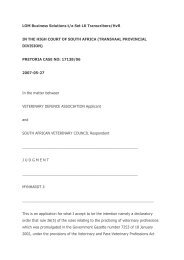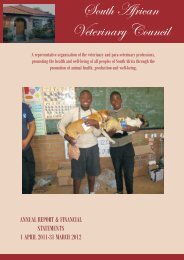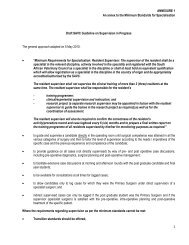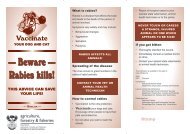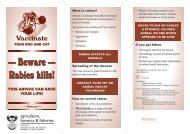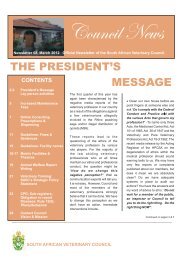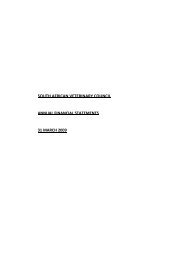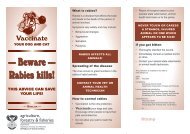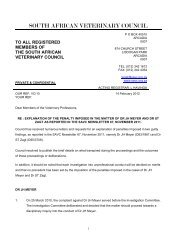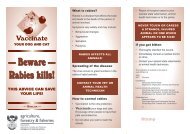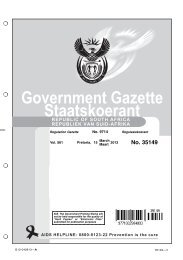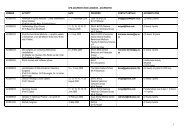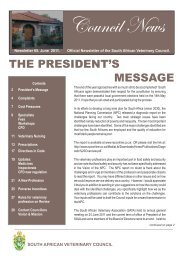Rabies Guide 2010.pdf - the South African Veterinary Council
Rabies Guide 2010.pdf - the South African Veterinary Council
Rabies Guide 2010.pdf - the South African Veterinary Council
You also want an ePaper? Increase the reach of your titles
YUMPU automatically turns print PDFs into web optimized ePapers that Google loves.
Quarantine facilities<br />
This should be a well-designed and constructed, dog<br />
and cat-proof kennel/cage from which <strong>the</strong> animal<br />
cannot escape during <strong>the</strong> quarantine period. It should<br />
be of sufficient size to house <strong>the</strong> animal comfortably<br />
and hygienically. The facility should also be designed<br />
so that <strong>the</strong> animal can be properly attended and <strong>the</strong><br />
cage cleaned with running water. This facility must be<br />
approved by a state veterinarian.<br />
Direct contact with <strong>the</strong> animal by humans and<br />
o<strong>the</strong>r animals must be avoided at all costs and<br />
gloves must be worn when feeding/providing water<br />
to <strong>the</strong> animal. Officials of <strong>the</strong><br />
veterinary department should<br />
inspect <strong>the</strong> facilities at least once<br />
a week. If <strong>the</strong> animal shows any<br />
signs of abnormal behaviour or<br />
illness, <strong>the</strong> state veterinarian must<br />
be notified immediately. All costs<br />
The presence<br />
of neutralising<br />
antibodies does<br />
not guarantee<br />
protection against<br />
rabies infection<br />
resulting from quarantine are incurred at <strong>the</strong> owner’s<br />
expense. Before entering quarantine, any animal<br />
with a vaccination history must be revaccinated and<br />
<strong>the</strong>n boosted three days later. The vaccine must be<br />
administered within one to two days after exposure.<br />
Animals which have had contact with rabid animals,<br />
regardless of <strong>the</strong>ir vaccination and immune status or<br />
type of contact, pose a risk of transmitting rabies to<br />
people and animals, should <strong>the</strong>y become rabid. The<br />
conditions of quarantine and element of risk associated<br />
with this course of action, must be conveyed to <strong>the</strong><br />
owner in writing (Fig. 10). It is recommended that all<br />
household members be vaccinated<br />
against rabies.<br />
Unfortunately adherence to <strong>the</strong><br />
quarantine requirements does not<br />
guarantee that <strong>the</strong> animal will not<br />
subsequently develop rabies.<br />
53



